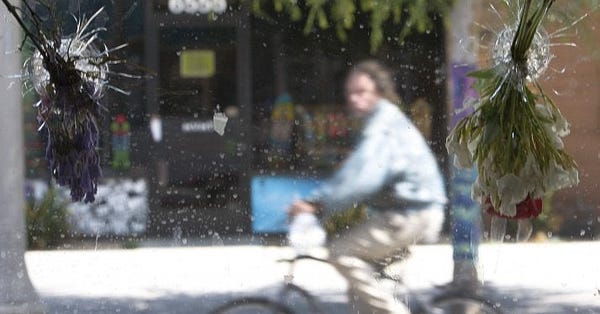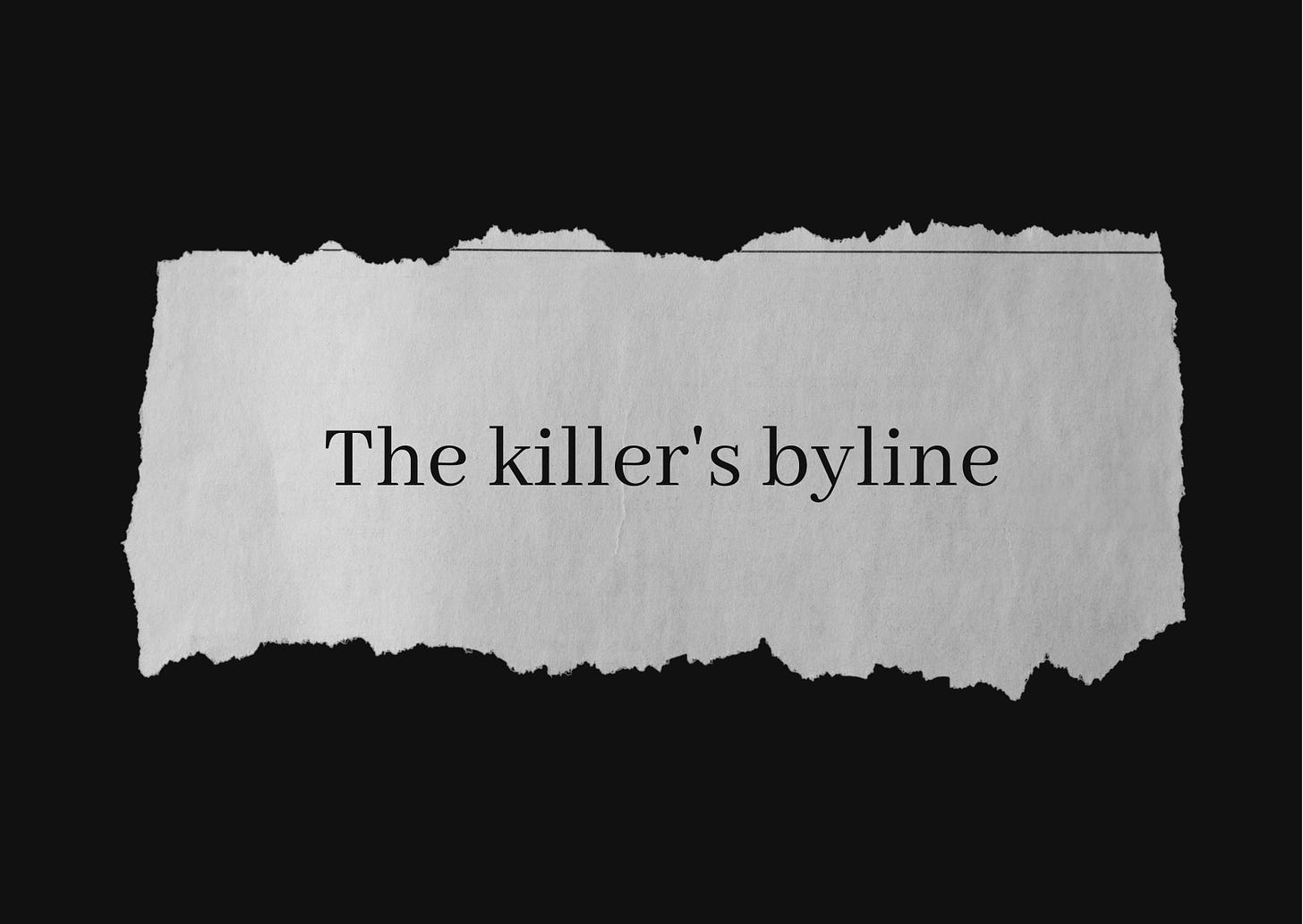The killer’s byline: Why the British media gives murderers the notoriety they crave…
[American news reporter voice]: It’s called 'sensationalism'....
This edition discusses violence, particularly violence against women. It does not name or picture any killer or discuss acts in detail but obviously feel free to skip this one.
When the news broke on Thursday that a man had shot and killed five people, including a three-year-old child, before taking his own life, what the media would do next was inevitable:
The killer’s name and face would be everywhere. His social media output — especially his YouTube videos — would be treated like the testimony of a reliable narrator. CCTV footage that told us nothing new would be splashed around by broadcasters and tabloids as “exclusive” as if it showed anything more than the prurient desire to see blood.
And when the inevitable systematic failures emerged — the calls to the police unanswered, the firearms returned, the mental health interventions that never came — they would be subsumed beneath the waves of coverage of ‘sinister online cults’ and the obsessions of this single killer. It must be the loner. People in authority will mutter that “lessons will be learned” but the truly necessary questions will, again, go unasked and unanswered.
The killer’s name, face, and words are everywhere. At bullet point, he has got himself a byline in every national newspaper. The more photogenic of the killers who came before him even got magazine covers — the Columbine murderers splashed on the front of Time in 1999, one of the Boston Marathon bombers (“the cute one” as if he were the George Harrison of homicidal rampages) doe-eyed on Rolling Stone, like some hipster hottie on his Hinge profile.
For most of Friday, The Daily Telegraph’s website front page greeted visitors with a large picture and the line “profile of killer”. It and the rest of the UK news media know that naming killers and plastering their pictures across coverage is known to inspire others. Academics and researchers have been saying as much for just a few decades now. But the sensationalism is just too irresistible.
There’s another way. In July 2018, after a mass shooting at a Maryland newspaper, while Fox News and The New York Post featured large pictures of the killer and focused on his actions, and The New York Times and Washington Post also named the killer, CNN.com chose differently.
The online CNN coverage focused on the five victims of the shooting, putting their first names — Rob, Gerald, John, Rebecca, Wendi — in its headline. The graphic pictured them. The image of the killer did not feature, neither did his name. NBC’s home page also opted not to feature a picture of the killer or to refer to him as anything other than “the suspect”.
It was a sign — a small one — that the No Notoriety campaign is getting a hearing in some American newsrooms. Founded by Caren and Ted Teves, the parents of Alex, a 24-year-old who was killed shielding his girlfriend with his body during the Aurora movie theatre shooting, the group encourages news outlets to focus on victims, survivors and emergency services and not killers.
Its principles could entirely change the focus, tone and effect of coverage if they were the default operating policy for papers and broadcasters. In full they are:
Adhere to the principle to ‘minimize harm’ keeping in mind the responsibility of balancing the public’s need for information vs. potential harm.
Recognise that the prospect of infamy serves as a motivating factor for other individuals to kill and inspires copycat crimes.
Report the facts surrounding the mindset, demographic and motivation profile, without adding complimentary colour to the individual or their actions, and downplay the individual’s name and likeness, unless the alleged assailant is at large.
Limit the name to once per piece as a reference point, never in the headlines, and no photo above the fold.
Refuse to broadcast/publish self-serving statements, photos, videos and/or manifestos made by the individual. After initial identification, limit the name and likeness of the individual in reporting, unless the alleged assailant is still at large and doing so would aid in their capture.
Agree to promote data and analysis from experts in mental health, public safety, and other relevant professions to support further steps to help eliminate the motivation behind mass murder.
The most prominent coverage of Thursday’s events — from national papers and the TV and radio broadcasters — cannot tick off any of that six-point list. A shift to images of the victims today does not outweigh the sheer number of words broadcast and printed about the killer, including many of his own statements pulled directly from YouTube videos and Reddit posts.
The competition among hacks to break stories in the aftermath of violent events like this one leads to a kind of ersatz journalism. It purports to taste of revelation and transparency but take a bite and you get the cheap sugar thrills of shock and sensationalism. The Sun and ITV News shouting loudly about CCTV footage of the killer — who is dead and whose identity is not a mystery — isn’t journalism but voyeurism. It tells us about nothing but the human instinct to rubberneck.
In a Newsnight appearance following a mass shooting at a German school in 2009, the forensic psychiatrist Dr Park Dietz explained:
We’ve had twenty years of mass murders throughout which I have repeatedly told CNN and our other media, if you don’t want to propagate more mass murder, don’t start the story with sirens blaring. Don’t have photographs of the killer, don’t make this 24/7 coverage. Do everything you can not to make the body count the lead story, not to make the killer some kind of anti-hero. Do localise the story to the affected community and make it as boring as possible in every other market.
In the clip above, Newswipe juxtaposes Dietz’s words with the way British news reporting at the time utterly ignored his suggestions. 12 years later and very little has changed. The media still makes memorials for killers.
In The Times, you’ll find quotes from the killer’s neighbours offering their instant amateur psychological assessments (“He was a great example of a sociopath.”) coupled with reams of the killer’s own words printed as if they should be taken as a credible explanation of motive.
The Daily Mail/MailOnline/Mail+ of course follows the same line finding lots to get its teeth into with the killer’s YouTube videos and, like the bulk of the rest of the media and press, squeezing the story down to a simple line: Loner radicalised by incel ‘cult’. This is a particular problem with the coverage of this incident and this killer. As the author, journalist and podcaster, Hussein Kesvani, told Ryan Broderick’s Garbage Day:
News outlets don’t have people working on ‘internet’ beats. So when they’re hit with something like this they’ll send out a home affairs reporter or maybe a crime reporter, who will repeat police press releases and basically say, “This person was part of a shady, anonymous online cult where he was poisoned with violent views and groomed into becoming a murderer.
The killer using the word ‘incel’ in at least one of his videos set the media pack off racing to explain the phenomenon again — just as they did the last time and the time before that — and, in many cases, they come back with a bodge job made up of mashed up Wikipedia and half-understood quotes. That’s why The Times has run copy like this…
The incel subculture began in the 1990s on internet forums where young dateless men would discuss their sexual inactivity. The forums are often characterised by discussions of resentment, hatred, misogyny and racism.
Adherents of the culture refer to having taken the “black pill”, which means they believe they will never have any success romantically or sexually.
… which is both reductive and ahistorical (the term ‘incel’ was actually the creation of a young woman back in 1997 and the intention was harmless and supportive, to begin with). Similarly, the “black pill” and “black pilling” is a lot more complicated as a concept than someone quickly Googling and scrabbling for sources is likely to discover.


Supposedly expert correspondents talking about incels as a cult or some kind of very organised group reveal instantly that they don’t know what they’re talking about and haven’t even the slightest notion of how online subcultures grow, operate, and evolve. And the culture of news reporting is never going to give them the time or space to learn.
This continued tin-eared approach to online culture and sub-cultures also means leads publications to do things like search for incels posting about the killer then place quotes from them on pictures of that individual. That effectively means that mainstream media outlets are creating memes that vastly amplify fringe statements and gives them attention that they desperately crave.
Not only does the killer get a byline, but his fans do too.
It’s understandable to want answers when someone commits such violent acts, but the media isn’t providing them here. It’s offering a story that feels like an answer but reaches its conclusion so quickly and based on such a flawed understanding of contributing factors that it may as well be an extremely grim fairy story. Readers are told that online communities are cults and that the thing to fear is the internet.


The hard issues of what policing is for and who it apparently serves, how guns are obtained and licenced, and how mental health services are supported get covered but they’re drowned out by the simple story of the monster. And in obsessing about the killer, the notoriety they did not have in life is given to them in death, another neon sign to call out to a future killer.
But it also suits those in power who don’t want to address failings in education, in health, in social care and social policy for the story to be about the killer.
If the readers, viewers, and listeners are convinced that the problem is online, out in the inky black of the internet’s most ‘unknowable’ shadows, then ministers can propose tough-sounding solutions. add another 100 pages to the Prevent policy, and as Kesvani told Garbage Day, “be used as the basis to support more surveillance and policing measures.”
And the newspapers who push their own flavour of misogyny on a daily basis can pretend that there is no thread that links the way they talk about sex, relationships, bodies, and society.
Weaponised misogyny does not begin or end on Reddit or 4Chan. A lot of those shells have ‘Murdoch’ stamped on the side. Others read ‘Daily Mail’.
Sorry, the newsletter hasn’t appeared as frequently this week. I’ve been unwell but am now on the mend (fingers crossed).
The paid subscriber-only post will be out on Sunday. If you’re not yet a paid subscriber but would like to help support me in writing CotU hit the button above. And thanks for reading.



